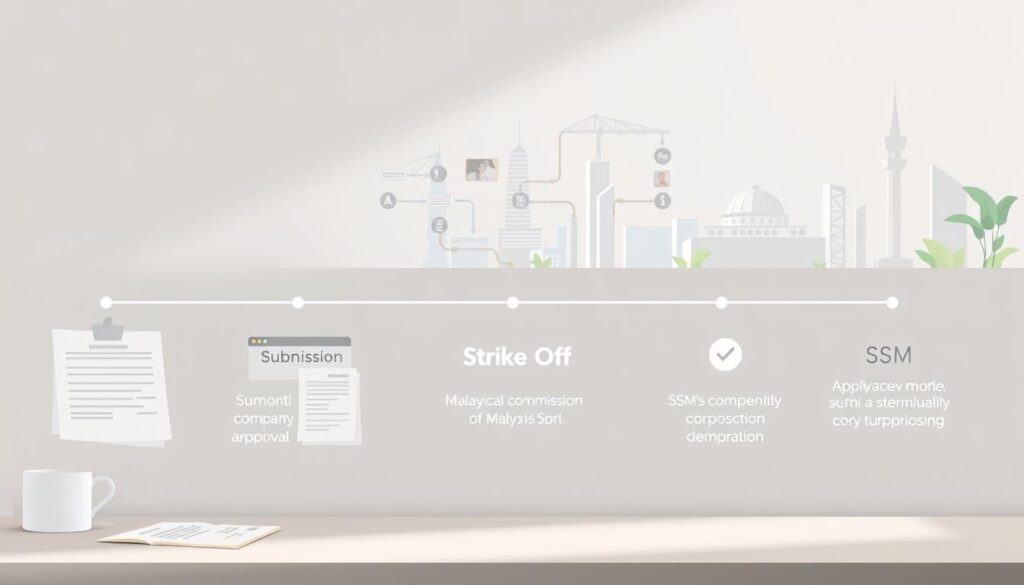This short guide answers the main question plainly so you can plan time and costs with confidence.
Striking off is the administrative dissolution route under the Companies Act 2016. The Companies Commission Malaysia (SSM) removes a company’s name after eligibility checks, public notice and Federal Gazette publication.
Expect a baseline of six months, though real cases often run from about 6–15 months. The final span depends on document completeness, public objections and SSM review speed.
Statutory fees are clear: RM100 for the application, RM300 for an objection window, and RM500 if an applicant withdraws within 30 days. Once the Gazette shows the name, the company ceases to exist and directors must keep records for seven years.
Key Takeaways
- Baseline time is roughly six months; many matters stretch to 6–15 months.
- SSM follows the Companies Act 2016 and uses Federal Gazette publication for legal effect.
- Budget for RM100 up front; know fees for objections and withdrawals.
- Complete paperwork first to avoid delays from follow-up queries.
- After removal, directors must retain statutory records for seven years.
Quick answer: timeline in days and months for an SSM strike off
Expect a six‑month baseline for a clean application, with many matters completing within about 6–15 months. That range reflects the combined time for SSM review, the public notification period, and Federal Gazette publication.
Typical range
The clock usually starts when SSM accepts a complete application and supporting documents. SSM then issues a notice that triggers a 30‑day public notification period. If no valid objection appears by the notification date, SSM moves to Federal Gazette publication, which sets the legal dissolution date.
Key factors that speed up or slow down the process
- Speeds: up‑to‑date filings, tax clearance, closed bank accounts, and no outstanding government dues.
- Slows: missing financials, unresolved liabilities, unclear approvals from directors or shareholders, and creditor queries.
- Professional packages (market estimate ~RM2,500) can reduce back‑and‑forth but statutory SSM fees remain fixed.
Who can apply and when a company qualifies under the Companies Act 2016
Eligibility hinges on a clean record: no assets, no liabilities, and no ongoing legal matters under act 2016. Sections 549–550 require the business to be inactive, solvent, and free from secured creditors or unresolved government dues.
Key requirements under Sections 549–550
To qualify, the company must have closed all bank accounts, kept SSM filings up to date, and not acted as a holding or guarantor entity.
Do not return capital to shareholders before applying. Any historic company assets should be documented and shown as disposed or transferred.
Who may lodge the application
A director, a shareholder, or a liquidator (if appointed) may file the application. Include a board resolution and a members’ resolution to show formal approval.
If signatories are missing, attach proof of reasonable attempts to contact those directors or shareholders. Many advisors also expect at least 12 months of inactivity and explicit confirmation of no secured creditors.
- Practical tip: Settle small debts and record asset disposals before filing to reduce risk of objections during the public notice period.
How many days will it take to strike off a company in SSM
Expect three clear phases: application and review, a 30‑day public notice, then Federal Gazette publication that removes the name from the register.
From submission to legal dissolution the minimum period often cited is about six months. Many matters run between 6–15 months depending on paperwork quality and objections.
Key timing points to plan around:
- The initial SSM review (RM100 fee) varies; complete supporting documents shorten this stage.
- Once a notice is issued, a fixed 30‑day public notification follows; any objection extends the timeline.
- Federal Gazette publication is the effective dissolution date; that publication is the final legal step.
Be responsive to requests from the companies commission and keep internal sign‑offs ready. A checklist‑driven approach reduces follow‑ups and limits extra days in the process.
Prerequisites to reduce delays: assets, liabilities, and tax clearance
Before filing, verify that every ledger and bank record reflects nil balances and no pending obligations. This step keeps SSM queries low and speeds up the application flow.
Settle liabilities, close bank accounts, and clear government dues
Start with a balance sheet that clearly shows no assets and no liabilities. Keep that report simple and signed by the director.
Close all bank accounts and keep closure letters. Reconcile vendor credits and deposits so there are no hidden debts that could trigger an objection.
LHDN tax clearance, EPF and SOCSO confirmations
Obtain tax clearance from LHDN and collect EPF and SOCSO confirmations. Small unpaid amounts or penalties can delay the notice stage.
“Small unresolved cents often cause the biggest delays—document every final payment.”
- Checklist: nil assets, settled liabilities, bank closure letters.
- Confirm: LHDN tax clearance and EPF/SOCSO acknowledgements.
- Verify: no secured creditors and up‑to‑date SSM lodgments.
| Prerequisite | Why it matters | Action |
|---|---|---|
| Nil assets & liabilities | SSM must see genuine nil position | Prepare signed balance sheet |
| Tax & social contributions | Government dues block progress | Get LHDN, EPF, SOCSO confirmations |
| Closed bank accounts | Prevents surprise transactions | Archive closure letters |
| Secured creditor clearance | Registered charges must be discharged | Obtain discharge documents |
Pack these items into one readiness set so your application can move from submission to public notice without friction. Pre-communicate with any party that might object to reduce risk during the 30‑day window.
Documents and resolutions SSM expects before you apply
Prepare a concise bundle of documents before you lodge the application. This reduces follow‑up queries and speeds review.
Board and members’ resolutions
Provide a clear board resolution and a members’ resolution that authorise the strike company request. Both must be signed, dated and match the company name on SSM records.
Statutory declaration and financials
Attach a statutory declaration confirming cessation of business and that there are no assets or liabilities. Add the latest financial statements that support that claim.
Supporting letters for missing signatories
If any directors or shareholders cannot be reached, include proof of reasonable steps taken — courier receipts, emails or returned notices. This prevents delays linked to missing signatures.
- Use the official strike off application form and double‑check the particulars.
- Include LHDN tax clearance and bank closure evidence.
- Ensure all SSM lodgments are up to date; the RM100 fee applies on submission.
- Add a short cover letter and an indexed checklist for quick verification.
| Item | Why | Action |
|---|---|---|
| Form | Official record | Complete and match SSM name/number |
| Resolution | Authorisation | Signed by directors and members |
| Statutory declaration | Eligibility proof | Confirm nil assets/liabilities |
The step-by-step process with time checkpoints
Follow three practical stages that map submission through Gazette publication, with time targets for each step. This gives clear checkpoints and helps you plan internal sign‑offs and document gathering.
Application submission to SSM and fee
Stage 1 starts when you file the official form with the full checklist and pay the RM100 fee to the Commission Malaysia. Include Appendix 1 (application) and Appendix 2 (checklist) to reduce initial queries.
Tip: clean packs shorten review and cut back‑and‑forth messages from officers.
SSM notice and 30‑day public notification window
After review, SSM issues a notice that triggers a fixed 30‑day notification period for objections. Officers may request clarifications during review; fast replies keep your timeline intact.
If an objection is lodged, expect extensions and possible fees; no valid objection moves the file forward.
Federal Gazette publication and effective date of dissolution
When the 30 days close, SSM publishes the company in the Federal Gazette. The publication date is the effective dissolution date and the register is updated.
Applicants may withdraw within 30 days via a Notice of Withdrawal (RM500). Keep a dated trail of all correspondent documents and SSM responses for verification.

- Application submission: form, checklist, RM100 paid.
- SSM review & notice: clarifications may follow; notice starts 30‑day window.
- Gazette publication: company removed from the register on the publication date.
| Stage | Typical timing | Key action |
|---|---|---|
| Pre‑submission | 1–3 months | Prepare documents and clear liabilities |
| Review & notice | 1–2 months | Respond to SSM queries; notice issued |
| Notification & Gazette | 30 days + several weeks | Public notification then Federal Gazette publication |
Objections, withdrawals, and how they affect your timeline
The 30‑day notification period is the key checkpoint where third parties may contest the application. During this window, SSM pauses progress if an objection appears and will not publish the Federal Gazette until the matter is resolved.
Who can object within 30 days and common grounds
Any interested person may lodge an objection by paying RM300. Typical objectors include creditors, shareholders, or members who claim unresolved sums.
Common grounds are: ongoing business activity, pending proceedings or court matters, receivership or liquidation, and outstanding debts. If the objector asserts the company is involved in legal proceedings, SSM often requests supporting documents.
Withdrawing an application and fees involved
If plans change, an applicant can file a Notice of Withdrawal within 30 days under Section 551(1) of the Companies Act 2016. The fee for withdrawal is RM500.
Key effect: objections or withdrawals extend the timeline. Clear, evidence‑based replies and negotiated settlements with objectors usually restore momentum faster than prolonged correspondence.
| Action | Fee | Effect on timeline |
|---|---|---|
| Objection lodged | RM300 | Pauses notification until resolved |
| Withdrawal by applicant | RM500 | Removes file from strike pathway |
| Unresolved creditor claim | Varies (settlement cost) | Likely removal from strike; may lead to court |
“Resolve disputes early — negotiated withdrawals save time compared with court or prolonged objections.”
After your company is struck off: what changes on the dissolution date
On the Federal Gazette publication date, the company legally ceases to exist and its powers end immediately. From that date the entity cannot enter contracts or carry on business. Any attempt to act after publication is invalid.
The company’s name is removed from the official register and records will show the cessation of existence. Open legal proceedings generally stop unless a court orders reinstatement.
Directors must keep registers, books, statutory records and accounting documents for seven years. These files support any future reinstatement or review by a liquidator or authority.
- Close bank accounts and cancel mandates before the Gazette date; payments tied to the entity will lapse.
- If assets surface after dissolution, get legal advice, since the company no longer owns or can transfer them.
- Interested parties may apply to court within seven years for reinstatement; a successful order can restore the company and its records.
“Treat dissolution as a final compliance milestone and keep contact details for directors and shareholders up to date.”
Alternatives if you don’t qualify: winding up vs dormant status
If your firm carries assets, creditors, or unresolved proceedings, a formal winding route is usually the safer path. This is common for Sdn Bhd that cannot meet the nil‑assets test required for a company strike.
Voluntary liquidation suits companies with assets or debts. Expect the winding process to cost roughly RM10,000–RM20,000 and often take 12 months or more.
A licensed liquidator takes control, realises assets, settles creditors in statutory order, and seeks a court dissolution. This route gives a definitive, court‑backed end when complexity exists.

Dormant status when you plan to pause operations
Choose dormant status if you expect to restart later. It reduces activity but does not remove compliance requirements with SSM and LHDN.
Quick comparison:
| Option | When to use | Typical cost/time |
|---|---|---|
| Winding | Assets, debts, or disputes | RM10k–RM20k; 12+ months |
| Dormant | Pause & resume later | Low cost; ongoing minimal filings |
| Strike company | Nil assets liabilities & no proceedings | ~RM2,500 packages; faster |
“If you are close to eligibility, clearing small bank balances and reconciling tax positions may let you choose a company strike rather than liquidation.”
- Discuss tax clearance early with LHDN.
- Pick winding when creditor protection and court orders are needed.
- Use dormant status for low‑cost pauses, not for permanent closure.
Reinstatement within seven years: court process and implications
Section 555 allows a court to restore a company’s name on the register within seven years when the striking was defective.
If a court finds the removal did not meet the requirements under the Companies Act 2016, it can order the company struck to be reinstated. The order aims to place interested persons as close as possible to their prior position.
Restoration can revive legal rights and pending proceedings. Once reinstated, lawsuits and claims that paused at dissolution may resume. Expect careful scrutiny of the facts at the original strike date.
- Any interested party, including a liquidator or creditor, may petition within seven years.
- The court reviews whether assets, liabilities, or proceedings existed when the strike happened.
- Reinstatement is discretionary, not automatic; the judge balances fairness and evidence.
“Keep seven years of organised records — they often decide the outcome of a reinstatement petition.”
Tip: If you face a petition, seek counsel early to assess whether to contest, settle, or consent to terms that protect your business and governance duties.
Conclusion
A careful, well‑packaged application is the single best way to keep the process swift and predictable.
If your business meets the Sections 549–550 requirements, a strike offers the fastest and most cost‑effective end. Expect a baseline of about six months and commonly up to 6–15 months from application through Federal Gazette publication.
Keep shareholders and directors aligned, gather final bank closure letters, tax clearances and signed resolutions, and prepare a tight documents bundle. That checklist reduces objections and SSM queries.
For firms with assets, liabilities or disputes, choose winding and court supervision instead. Remember: a company struck may be reinstated by court within seven years if the original process was defective—so be meticulous now.
FAQ
What is the typical timeline for striking off under the Companies Act 2016?
Generally, the process ranges from about six months up to 15 months. The clock starts when the Companies Commission of Malaysia (SSM) receives a complete application. Key checkpoints include SSM’s initial review, a 30-day public notification period, and Federal Gazette publication before dissolution becomes effective.
Who is eligible to apply under Sections 549–550 of the Companies Act 2016?
A company that is non-operational, with no assets, no liabilities, and no outstanding statutory filings usually qualifies. Directors, shareholders, or a liquidator may lodge the application, provided the company meets the legal criteria and submits required declarations.
What can speed up or slow down the timeline?
Faster timelines follow when liabilities are settled, bank accounts closed, and LHDN tax clearances obtained. Delays occur if SSM requests missing documents, creditors object, or there are unresolved registrations with EPF or SOCSO.
Which documents and resolutions does SSM expect with the application?
Prepare a board resolution and shareholders’ resolution approving the strike-off application, a statutory declaration confirming no assets or liabilities, the latest financial statements, and up-to-date SSM filings. Supporting letters explaining absent directors or shareholders may be required.
What are the key steps and time checkpoints during the process?
Steps include submitting the application and fee to SSM, SSM’s preliminary review, publication of a 30‑day notice for objections, and Federal Gazette notice. Each stage has administrative time; the statutory 30-day objection window is a fixed minimum.
Who can object and how do objections affect the schedule?
Creditors, regulatory bodies, or any interested party can object during the 30-day public notice. A valid objection halts cancellation and may require creditor resolution, settlement of debts, or court action, which extends the timeline significantly.
Can an applicant withdraw an application? Are there fees or penalties?
Yes, an applicant can withdraw before the process completes. Withdrawal procedures and any nonrefundable fees depend on SSM’s rules at the time; if costs were incurred for notices or Gazette publication, those may not be recoverable.
What happens on the effective date once the company is struck off?
After the Gazette notice takes effect, the company is dissolved and removed from the register. It ceases to exist as a legal entity. Any remaining assets may vest in the government under the Treasury Laws, and officers may still face liabilities if obligations were not met.
What prerequisites help reduce delays before applying?
Ensure all liabilities are settled, bank accounts closed, and statutory filings up to date. Obtain LHDN tax clearance and confirmations from Employees Provident Fund and SOCSO if applicable. Preparing complete statutory declarations and financials speeds up SSM review.
If a company does not qualify, what alternatives exist?
Consider members’ voluntary winding up if there are assets and a solvent position, or apply for dormant status to pause filings while preserving the company. Voluntary liquidation takes longer and involves appointing a liquidator and creditor notices.
How long can a struck-off company be reinstated and what is the route?
Reinstatement is possible within seven years by court application. Interested parties must petition the court and show cause for restoration. Court-ordered reinstatement may require settling outstanding matters, and it involves additional time and legal costs.
Are tax, EPF, and SOCSO clearances mandatory before applying?
While SSM focuses on corporate eligibility, practical clearance from LHDN, EPF, and SOCSO avoids later objections and delays. Many applicants obtain formal confirmations to reduce the risk of post-strike disputes and prolonged reinstatement actions.

